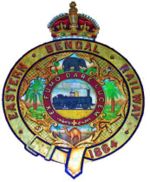Eastern Bengal Railway
| Eastern Bengal Railway | ||
|---|---|---|
| [[Image:|150px| ]] | ||
| Line of route | ||
| Calcutta to Faridpur (BG) with branches to Budge Budge, Diamond Harbour, Lalgola | ||
| Gauge / mileage | ||
| Broad gauge | 495 miles (1905) | |
| Metre gauge | 637 miles (1905) | |
| 2' 6" NG | 55 miles (1905) | |
| Timeline | ||
| 1857 | Formed as Guaranteed company | |
| 1868 | Calcutta and South Eastern Railway taken over | |
| 1884 | Taken over by State | |
| 1915 | Opening of Hardinge Bridge at Sara Ghat | |
| Key locations | ||
| Presidency | Bengal | |
| Stations | Sealdah, Dum Dum, Naihati, Kaliganga, Rajbari, Goalundo, Ranaghat, Krishnagar, Plassey, Murshidabad | |
| System agency | ||
| 1884 | State agency | |
| How to interpret this infobox | ||
| Eastern Bengal Railway | ||
|---|---|---|
 Eastern Bengal Railway device | ||
| System timeline | ||
| 1884 | Renamed Eastern Bengal State Railway | |
| 1915 | Reverted to Eastern Bengal Railway | |
| Constituent companies / lines | ||
| 1868 | Calcutta and South Eastern Railway | |
| 1887 | Dacca State Railway | |
| 1887 | Northern Bengal State Railway | |
| 1887 | Kaunia-Kurigram Railway | |
| Cooch Behar Railway | ||
| Mymensingh-Jamalpur-Jagannath Railway | ||
| 1904 | Bengal Central Railway | |
| Brahmaputra-Sultanpur Railway | ||
| 1941 | Bengal Dooars Railway | |
| Key locations | ||
| Headquarters | Calcutta | |
| Workshops | Kanchrapara See EBR Kanchrapara Railway Worshops | |
| Major Stations | Bangaon, Jessore, | |
| Successor system / organisation | ||
| 1942 | Merged into Bengal and Assam Railway | |
| System mileage | ||
| Broad gauge | 495 miles (1905) | |
| Metre gauge | 688 miles (1905) | |
| 2' 6" NG | 89 miles (1905) | |
| Associated auxiliary force | ||
| Eastern Bengal Railway Battalion | ||
| How to interpret this infobox | ||
The Eastern Bengal Railway Company (EBR) was formed as a Guaranteed Railway company in 1857 for "the construction and working of a line from Calcutta to Dacca, with a branch to Jessore. Capital 1,000,000l. This amount has been sanctioned for the line from Calcutta to the Ganges at Kooshtee(Kushtia), near Pubnah, about 80 miles, all that is authorised to be proceeded with at present. Rate of Interest Guaranteed - 5 per cent on 1,000,000l " [1].
History
The first construction started in October 1859. Isambard Kingdom Brunel had been engaged in Britain as consulting engineer to the EBR and Bradford Leslie, an English civil engineer who specialised in bridges, was sent to India as engineer in charge of bridges and viaducts. He supervised the building of the Eschamutter and Koormar river bridges before returning to Britain in 1861. He returned to India in 1865 and became Chief Engineer and Agent [2] [3].
Franklin Prestage became the Agent for the EBR in the early 1870's. In its original contract with the Secretary of State for India, the EBR Company was to open a rail-line to Darjeeling. However the Government of India took a decision to stop expansion of rail-lines by Guaranteed companies in new areas and instead decided to construct and manage new rail-lines as State Railways. Prestage resigned from EBR and in 1879 set up the Darjeeling Steam Tramway Company [4].
The EBR became the Eastern Bengal State Railway(EBSR), owned and managed by the Government of India(GoI), on 30 June 1884.
The GoI merged the broad gauge(BG) Calcutta and South Eastern Railway into the EBSR, and in 1887 several metre gauge(MG) and narrow gauge NG railways Railways – this giving the three Rail Gauges that made up the EBR network.
In 1915, the system reverted to the style, Eastern Bengal Railway.
During the 1920s, the EBR continued to grow by merger and amalgamation, and also began to convert sections of metre and narrow gauge to eliminate rail bottlenecks.
On 1 January 1941, the GoI acquired the Bengal Dooars Railway and merged it into the EBR.
In 1942, the GoI merged the EBR with the Assam Bengal Railway to create the Bengal and Assam Railway.
EBR Personnel
See separate page Eastern Bengal Railway Personnel
EBR Lines owned and worked
The development of the EBR network is detailed in a separate page Eastern Bengal Railway - Lines owned and worked broken down into the three Rail Gauge Divisions.
External Links
- Banglapedia "National Encyclopaedia of Bangladesh" Railway
- "Brief History of Bangladesh Railway" Bangladesh Railway Information
References
- ↑ "Money Market and City Intelligence", The Times, Wednesday, 15 June 1859, #23333, 7a.
- ↑ Wikipedia "Bradford Leslie"; Retrieved on 5 May 2016
- ↑ Google Books “New Delhi: The Last Imperial City- Sir Bradford Leslie and the meaning of Empire, Chapter 5.3” by D. Johnson, Richard Watson"; Retrieved on 2 Jun 2016
- ↑ “Eminent Railwaymen of Yesteryears” by R R Bhandari July 2008, reproduced by IRFCA Indian Railways Fan Club Retrieved on 2 Jun 2016
